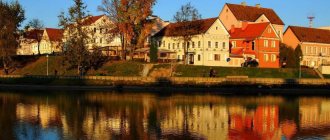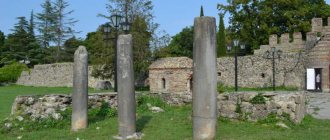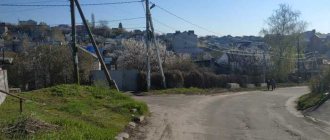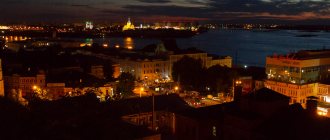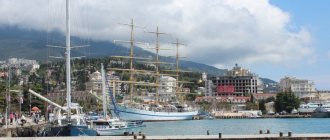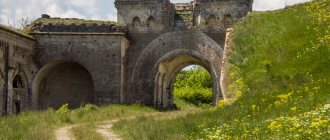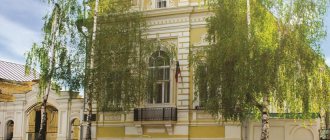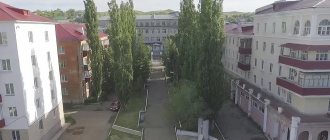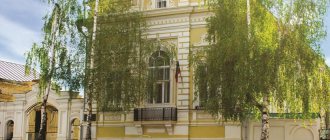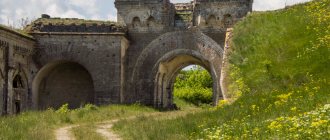Surprisingly, tourists rarely visit the attractions in Severodvinsk - the “city of northern shipbuilders”, the shipbuilding center of North-West Russia, in a picturesque place in the Arkhangelsk region, where the harsh White Sea receives the waters of the Northern Dvina. By the standards of Russian history, he is quite young. The settlement of shipbuilders, which gave it its beginning, arose already in Soviet times - in 1936. It was renamed several times, bore the names “Sudstroy” and Molotovsk, and the current one acquired in 1957.
The main attractions in Severodvinsk – TOP-5
First, about the most interesting places in Severodvinsk that you need to visit even if your visit to the city takes only one day.
Museum of the production association "Sevmashpredpriyatie"
- Address: Arkhangelskoe highway, 58.
In an industrial city, the main attraction, the center of life, everyday life and history is production - the city-forming enterprise. In Severodvinsk this is a shipbuilding plant, known under the abbreviated name "Sevmash".
He gained fame by making submarines. Of interest to tourists is the museum operating at the enterprise, which tells about the formation and development of local shipbuilding, the history of which is closely intertwined with the past of the entire city. The museum pays attention not only to “local subjects”, but also to milestones in the history and modernity of the Russian Northern Navy as a whole.
Many boys will be interested in ships; the museum’s exhibition will not leave them indifferent, offering an educational and exciting immersion in industrial and naval topics.
Nikolo-Korelsky Monastery
- Address: Arkhangelskoe highway, 58, building 75.
One of the few ancient attractions that reveals the history and culture of the area many centuries before the city was founded. According to legend, the monastery arose at the site of the death of two young people - Anthony and Felix, the sons of Martha the Posadnitsa from Novgorod. The grieving mother ordered a temple to be built here, consecrated in honor of St. Nicholas.
The temple complex operates to this day, and services are still held there. But the history of the monastery itself ended even before the city of Severodvinsk appeared on the map of the country. It was closed in 1920; by that time the monastery had a rich history and glory as a “cultural and educational” center of the northern region.
There was once a school here that taught children from the surrounding villages. In 1731, the most famous native of the Arkhangelsk land, Mikhail Vasilyevich Lomonosov, walked through the monastery. The history of the monastery includes the fact that it was the monastery convoy that helped the future luminary of Russian science get to Moscow.
Even in tsarist times, the monastery was used for the “exile” of unwanted people; this “unpleasant” function was performed by it even after its closure. The Soviet authorities set up labor camps here. From 1938 to 1961 the infamous Yarinlag was located here. Nowadays, part of the monastery premises is occupied by shipbuilding production.
Monument to M.V. Lomonosov
- Address: Lomonosov Square.
The Arkhangelsk lands and the territories of modern Severodvinsk are associated with the names of several famous people; the figure of Mikhail Lomonosov definitely stands apart in this list. Even though he did not live here, like many cultural figures, but only passed by, his figure is significant for the entire region.
The famous scientist and writer was immortalized in Severodvinsk in 1958. The local monument is one of the most famous sculptural incarnations of Mikhail Vasilyevich.
The monument by sculptor M. Aleshchenko and architect M. Nasekin is located at the intersection of Lenin Avenue with the street named after the scientist. The figure of the encyclopedist, 3.5 meters high, is mounted on a cylindrical concrete pedestal with a tablet indicating the years of his life.
Wheeled river steamer "N.V. Gogol"
The appearance of the city of shipbuilders would not be complete without shipbuilding monuments. An interesting city object that combines historical, educational and entertainment functions is a paddle steamer named after the great Russian writer Nikolai Vasilyevich Gogol.
The thing is that the ship, manufactured in 1911, is still on the move and is used for tourist boat trips. The ship became a pleasure ship in the early 70s. after major reconstruction. Before that, it regularly served for the benefit of the people, carried out cargo transportation, and during the Second World War it was used to transport the wounded.
Kudemskaya narrow gauge railway
- Address: pos. White Lake.
For a tourist, a railway is a useful infrastructure facility that allows you to get to your travel destination. However, it happens that the railway track itself is already a historical and cultural attraction. This is exactly the case of Severodvinsk.
The Kudemskaya narrow-gauge railway passing here is officially included in the list of the ten most beautiful railway routes in the world. The history of the railway began in 1949, when its first section was opened. Carried out passenger and cargo transportation, primarily used for timber transportation.
The narrow-gauge railway still performs these functions today, although the scale of local logging production is currently modest compared to previous stages. Until now, the railway remains unelectrified.
Severodvinsk
Video: Severodvinsk from above
History: from Shipbuilding to Severodvinsk
It is believed that the discovery of lands in the vicinity of the Northern Dvina was the work of the Vikings. Starting from the end of the 9th century, warlike sailors regularly visited Pomerania, until in the 12th century Veliky Novgorod took the Severodvinsk lands under its wing. The construction of the Nikolo-Korelsky monastery at the Nikolsky mouth of the Dvina, which later became the sea gate to Europe for pre-Petrine Rus', also dates back approximately to this time period. But the history of Severodvinsk as such dates back only to 1936, after the Soviet government adopted a decree on the construction of a shipbuilding plant in these parts. The future enterprise was supposed to spread out its shipyards precisely on the territory belonging to the Nikolo-Korelsky monastery and replenish the domestic fleet with new ship structures. They didn’t go too far with the name of the new village, dubbing it Shipbuilding. True, just two years later the settlement was given the status of a city, renaming it Molotovsk - in honor of the popular political figure V. M. Molotov in those years.
During the Great Patriotic War, the former Shipbuilding turned into a port of strategic importance: the city received cargo ships of the allied countries, but almost all the military glory went to Arkhangelsk and Murmansk. They remembered Molotovsk only in the early 50s, in connection with the launch of the production of nuclear submarines. The Moscow authorities considered the port on the White Sea an ideal place for the implementation of such a grandiose plan, which is why the city was once again renamed: this time preference was given to the politically neutral name Severodvinsk.
Severodvinsk today
Having survived the decline and economic depression of the 90s, local city-forming enterprises were somehow miraculously able to stay afloat, so the title of “city of shipbuilders” still remains with Severodvinsk. However, today it is engaged not so much in the construction of ships, but in the design and testing of nuclear submarines (Sevmashpredpriyatie), as well as their repair (). It is clear that the activities of such giants of the defense industry did not have the best impact on the environmental situation in the city, not to mention the underground sarcophagi 20 km from the port, in which the management of the enterprises “stores” nuclear waste and other by-products of submarine disposal. However, the local residents themselves look at such a dangerous neighborhood with a degree of healthy optimism, never tired of making sophisticated jokes about genetic mutations and their extraordinary “survivability.”
For your information: for quite a long period, Severodvinsk was a closed city, and not every citizen of the union could freely enter it. Today there is no “face control” for Russians in the former Molotovsk. But a foreign tourist who intends to explore the port will have to spend a lot of time going through the authorities in order to get an entry permit.
Climate
Severodvinsk is, in fact, the Far North. And although the city officially belongs to the temperate maritime climate zone, the weather conditions here are far from resort-like. Summer in the former Molotovsk is short and unkind: the average temperature in July is only +16 °C, in addition, even at this time of year the city experiences night frosts. In winter, Severodvinsk is covered with snow and frozen. A typical January for Pomeranian shipbuilders is -15 °C on the thermometer and regular blizzards, but during the winter the temperature scale often drops to -30 °C. Adding to this already unsightly weather “bouquet” is year-round high humidity, which makes the cold feel more acute.
City districts
Severodvinsk is located at the confluence of the Dvina and the White Sea, west of Arkhangelsk. Administratively, the city with 183,996 inhabitants is divided into three zones: the main part or the city itself, neighborhoods and the island of Jagry. The most boring area from a tourist point of view is the quarterly area or the so-called Zaozerny District, which is a classic residential area with standard buildings and a complete absence of any significant attractions.
The main part extends from northeast to southwest and is divided into the center, as well as the old and new town. The entire cultural and business life of Severodvinsk is in full swing in its center, which is both the trading core and the location of the city drama theater. Connoisseurs of wooden architecture usually delve into the old areas of the former Molotovsk: although the local authorities have vowed to get rid of the rickety mansions from the times of the “Father of Nations” as soon as possible, in the historical part of Severodvinsk there are still plenty of dilapidated, but charming wooden buildings in their own way.
Yagry Island, hidden behind the local industrial zone, is perhaps the most picturesque area of Severodvinsk, whose peak popularity occurs in the summer months. It is on his land that the city embankment, a cozy forest park and a sea beach are located. For everyone who is interested in the history of the Pomeranian region, the guides of the local history museum will definitely tell you how the ship of the British expedition "Edward Bonaventure" once moored off the coast of Jagra, whose team gave the island the name "Pink" because of the abundance of flowering rose hips and rosemary on it. By the way, today you no longer need to swim to Yagr: the island has long been connected by a system of bridges and dams to the mainland of Severodvinsk.
Attractions
Severodvinsk is a city with a typical Pomeranian character: not arrogant, slightly harsh and completely devoid of loud gloss. The streets of the shipbuilders’ homeland are almost always not crowded, which, in general, is not so unusual for a closed city that has been working diligently on the military-industrial complex for more than 80 years. Truly historical and cultural attractions are scarce in Severodvinsk (numerous monuments to grandfather Lenin and a monument to the most erudite Pomeranian, Mikhailo Lomonosov, don’t count). This is understandable: conceived as a center of domestic shipbuilding, this secret city at the mouth of the Dvina initially developed not on its own, but in a strictly given direction. Harsh weather conditions also contributed to the somewhat ascetic appearance of the port.
And yet, Severodvinsk is infinitely far from the stereotypical image of a gray provincial town with nothing to see. Of course, local architectural monuments can hardly be called outstanding, but this “ship master” has everything at the highest level when it comes to natural beauties. So the most useful advice that can be given to a tourist who has climbed into these regions is to place maximum emphasis on forays around the surrounding area and admiring the delightful landscapes of the Russian north, but it is better to run through man-made attractions at a marching pace.
The first thing that greets a traveler who has finally reached the northern port is a memorial stele at the entrance to Severodvinsk. It is customary to linger near a simple memorial just long enough to take a good photo against its background. Tourists who are interested in the history of the Russian nuclear fleet can try to make their way to the Sevmashpredpriyatie museum. Only factory business travelers, as well as all kinds of delegations, are allowed into it, so you will have to run for permission, but, according to the lucky ones who made their way “into the holy of holies,” the local exhibition more than pays for the efforts spent. Models of the latest submarines built for the Russian fleet, a piece of the hull of the infamous Kursk, the neck of a bottle broken on the side of the Varshavyanka submarine, built at one time for the Chinese army - on the shelves of this unusual museum you can sometimes find the most unexpected exhibits marine theme. Those who were unable to get hold of a pass to Sevmashpredpriyatie can find some comfort in the local history museum. Nuclear-powered ships, of course, will not be shown here, but they will tell you with great pleasure about the life of the Pomeranians and the history of the city.
The Nikolo-Korelsky Monastery, considered the oldest building in Severodvinsk, is also not offended by the attention. After the founding of Molotovsk, shipbuilding workshops spread out around the monastery building, so today you can get into the monastery chapels only with the official permission of the plant management. The second iconic building of Severodvinsk is St. Nicholas Church with the Alexander Nevsky Chapel. The appearance, somewhat atypical for a religious building, is explained by the fact that the building originally housed a kindergarten, and only after it had become thoroughly dilapidated was the building handed over to the diocese, which used parishioners’ money to build a church in it. The fate of the Church of the Resurrection of Christ on the island of Jagry is very unusual. The dilapidated century-old building was transported to Severodvinsk from the village of Solza and gained popularity among pilgrims after a miraculous discovery: during the dismantling of the building, a cache with an icon of the Sign of the Blessed Virgin Mary was discovered within its walls.
The Nordic character of Severodvinsk is reflected even in small sculptural forms. Cartoon characters and heroes of folklore are not cast in metal here: all the monuments in the city are extremely serious, and sometimes even mournful, monuments. For example, in the Jagr forest belt you can find a marble slab installed in memory of the sailors who died on the Kursk submarine. On the same island there is another sad memorial - the Grieving Motherland. Those walking along the Yagrinskaya embankment can find a memorial stone there, laid in honor of the arrival of the English navigator Richard Chancellor (the same Edward Bonaventure expedition) to these parts. By the way, the embankment itself bears the name of A. Zryachev, director of the ship repair yard, as evidenced by a memorial sign in the form of a screw blade with the name of the “manager” inscribed on it, installed at the beginning of the promenade.
The Kudemskaya narrow-gauge railway and the paddle steamer Nikolai Vasilyevich Gogol, which takes tourists along the Dvina, stand out somewhat from the general range of Molotov attractions. The first one remains operational to this day, so five days a week passenger trains travel along its rails from Severodvinsk (Vodogon station) to the village of Beloe Lake. But the ship sails only in the spring-summer season, so if you are eager to join the excursion, try to arrive in Severodvinsk before navigation closes.
Those who plan to enjoy the beauties of Pomerania with their children are advised to visit the City Park of Culture and Recreation to introduce the younger generation to original retro attractions. You can barbecue, hand-feed squirrels, or test the trails made by local skiers in the Yagrinsky pine forest. The forest belt area has been declared protected; in addition, it contains several interesting monuments. In the spring-summer season, you can also look at Lake Chayachye, located next to the residential areas of Yagra. Usually, city residents come here with families to have a little fun and also to feed the seagulls and ducks nesting in the coastal reed thickets. Fans of remote taiga towns and Nordic landscapes can take a ride to the Onega Pomorie National Park. The place is famous for its unique fauna and rich flora, so if you want to see real harp seals, beluga whales and bird colonies, this is the place for you.
Beach holiday
Paradoxically, beach holidays do take place in the Far North, and Yagrinsky Beach is proof of this. In summer, everyone flocks to the sandy strip, stretching for almost 4 km, who cannot imagine life without a tan and cool baths. The sea in these places is shallow, so in the warm season the water is relatively warm. However, only winter swimmers dare to take serious swims here: mostly Severodvinsk residents come to the beach to wander a little in the shallow water or just take a dip.
Urban transport
You can get around Severodvinsk by bus, minibus or taxi. The first ones are represented here mainly by “grooves” and low-floor options, one trip of which will cost 25 rubles. In total, the city has more than 30 bus routes, covering all districts of Severodvinsk. For example, you can get from the main part of the city to Yagry Island by buses and minibuses No. 1, 10, 15, 22, 26 and 28.
Payment in Severodvinsk taxis is usually recorded by a meter. The classic tariff of local taxi companies is 100 rubles. for landing and 13-15 rubles. for every kilometer of travel. Some companies charge hourly rates: on average, 450-550 rubles per hour of travel.
Phone numbers of some Severodvinsk taxis:
- "Rainbow" -,;
- "Maxim" –$.6;
- "5 minutes" -.
Where to stay
There are about a dozen hotels and hostels in Severodvinsk, but almost all of them are “starless”. The most expensive options are the Mama Leone and Nikolsky Posad hotels. An overnight stay in a double room at the mentioned establishments will cost from 4,000 rubles. A little cheaper in Volna, Nordsky and Hermitage - 3000-3600 rubles for a room with Wi-Fi and breakfast included. With a budget of 2000-3000 rubles. You can go to economy hotels like Parkovaya or rent a cozy one-room apartment from one of the locals. An overnight stay in the Severodvinsk hostel “Trukhinova 3” will cost 600-700 rubles, but provided that you are satisfied with a bed in a common room. A separate room in the same establishment is priced almost like a room in a budget hotel, that is, from 2000 rubles.
Booking.com
Restaurants and cafes
Prices in Severodvinsk are traditionally “northern”, so be prepared for the fact that the check at local taverns may be a little surprising. The main type of Severodvinsk catering outlets are stylish cafes, gastro bars and canteens. It’s better to taste Italian cuisine while singing karaoke between shifts in the Mama Leone restaurant, which operates at the hotel of the same name. “Puzov” has a good assortment of beer and simple salads, “Meat” has perfect steaks and an extensive offer of hot dishes, and “Brothers Grill” offers meat and fish cooked over an open fire. Lovers of burgers and fries will find comfort in their local McDonald's, while simple carb eaters shouldn't be put off by a visit to Slastoria, a charming pastry shop that has made its reputation on mind-blowing desserts and fluffy pastries.
How to get there
The most convenient option for traveling to Severodvinsk is by plane, but since the homeland of shipbuilders does not have its own airport, you will have to fly to Arkhangelsk. The northern airport of Talagi is connected to the Mother See by daily flights of Aeroflot (departure from Sheremetyevo), Nordavia (Domodedovo Airport) and Uteira (departure from Vnukovo). You can get from Arkhangelsk to Severodvinsk by buses that depart every 20-30 minutes from the Central Bus Station (route No. 133) and the Sea Terminal (No. 138). The same route, but only much faster, can be done by taxi. The average cost of a trip from Talagi airport to Severodvinsk is 1000 rubles.
In addition, a train runs between Moscow and Severodvinsk. The train runs on even numbers and spends 22 hours 46 minutes on the way. Desperate car enthusiasts can make the same journey in 16 hours in their own car. To do this, you will have to leave Moscow on the Yaroslavskoye Highway, whose logical continuation is the M-8 Kholmogory federal highway.
Calendar of low prices for air tickets
Severodvinsk museums and theaters
Cultural recreation is an integral part of a tourist excursion. In Severodvinsk, tourists can visit several museums, a theater and a cultural center.
Local Lore Museum of Severodvinsk
- Address: Pionerskaya, 10.
The function of covering local history is sufficiently covered; according to some visitors, it is not inferior in this regard to the “profile” one - local history. However, even the city’s local history exhibition will find something to surprise the independent tourist.
Here the visitor will be told about the life and culture of the Pomor people, who lived in these places since ancient times, about the first settlements and the first seaport in the Russian North, located on the territory of present-day Severodvinsk. The museum's halls are dedicated not only to history and culture, but also to the nature of the harsh northern lands along the shores of the White Sea.
Both the exhibition of the local history museum and the building itself are noteworthy. It is an architectural monument and played an important role at the beginning of the city's history. There was a maternity hospital here, where people who could confidently call themselves the first indigenous people of Severodvinsk saw this world.
Museum of Exploration Work (VPK Edelweiss)
- Address: Oktyabrskaya, 37.
There is also an unusual museum in the city dedicated to search work. Its creation is connected with the activities of the local military-patriotic club “Edelweiss”. The main theme of the club is dedicated to the Great Patriotic War, including the search for remains and trophies of war times. Members of the club organized several search expeditions, and the findings became museum exhibits. The exhibition, which occupies five halls, has been operating since 1995 and is considered the first of its kind in the Arkhangelsk region.
MAUK Severodvinsk Drama Theater
- Address: Lomonosova, 77.
The Severodvinsk Theater began its existence almost simultaneously with the city. In 1937, the artists first appeared on stage, presenting to the public a production based on the play “The Liar” by Carlo Goldoni. Since then, the following works have been performed on the theater stage of Severodvinsk:
- W. Shakespeare and L. Tolstoy,
- F. Dostoevsky and V. Nabokov,
- M. Gorky and A. Chekhov,
- Lope de Vega and other classics.
The Drama Theater is a good place to relax with children in Severodvinsk; the local troupe’s repertoire includes more than 10 children’s performances. The city theater is famous not only for its performances; it also hosts excursions, as there is a museum attached to it, which will be interesting for both children and adults to visit.
Shipmaker's House
- Address: ave. Lenina, 14.
One of the centers of cultural life in Severodvinsk bears the characteristic name “House of Shipbuilders” and serves as a city palace of culture. This is the most famous concert hall in the city, a venue for events of various types.
Creative groups from Severodvinsk and other cities in the region perform here, artists of “federal scale” tour, show programs and children’s parties are held.
The building of the House of Culture - a typical example of Soviet architecture - adorns the main city square with its majestic appearance. At the entrance, guests are greeted by the most popular monument of all Soviet and Russian cities - Vladimir Ilyich Lenin.
Submarine on the beach of Severodvinsk
Yagrinsky Beach of Severodvinsk is included in the top 10 most amazing beaches, along with the beaches of Brazil and other tropical countries. But not for the picturesque northern landscapes, but for an incident that occurred in 2006. In July 2006, at the height of the swimming season, the nuclear submarine “Akula” surfaced several kilometers from the coast. The photo of a submarine on the beach of Severodvinsk in a matter of days became one of the most popular in the whole world. Foreigners were amazed by the sight of a giant underwater vehicle with serene vacationers in the foreground.
The residents of Severodvinsk themselves emphasize that this is not an isolated case. From time to time, opposite the Yagra beach, submarines surface, “returning home” to the port. On the Internet, by searching “Submarine on the beach of Severodvinsk” you can find photographs from different years, including 2019–2020.
Video: submarine exit off the beach of Severodvinsk
Sights of the surrounding area of Severodvinsk and parks
The harsh northern nature has always attracted true aesthetes; it fascinates, enchants, exalts. Severodvinsk has several natural attractions and parks that are definitely worth seeing for travelers.
Embankment named after Alexandra Zryacheva
- Address: emb. named after Zryachev.
Severodvinsk is a coastal city and port. It is located not on any body of water, but on one of the northernmost seas of Russia. The White Sea in all its glory opens from the city embankment, which has become a popular place for walking for locals and tourists. There are observation decks for admiring the views.
You can not only walk along the embankment, but also ride a bicycle; there are bicycle paths here. The coastal area is decorated with replicas of ship cannons. The embankment bears the name of an honorary citizen of the city, the legendary shipbuilder Alexander Zryachev. A memorial sign was erected in his honor.
Dvina Bay
- Coordinates on the map: 65.056347, 39.000116.
Severodvinsk is located on the shores of one of the four largest bays of the White Sea, it is called Dvinskaya Bay. It got its name from the largest local river flowing into the White Sea. In addition to the Northern Dvina, many other small rivers merge with the sea here.
The depth in the bay reaches 120 meters, but shallow areas are also known, for example, the so-called “Dry Sea”. We are talking about a picturesque, vast, dry sandbank. It is interesting that Dvinskaya Guba, along with Onega, is one of the warmest areas of the White Sea.
Yagry Island
- GPS coordinates: 64.613677, 39.821679.
The center of natural attractions and monuments in Severodvinsk is Yagry Island, located at the mouth of the Northern Dvina River. This is a favorite place for recreation and fishing. Tourists and townspeople are attracted by the Yagrinsky pine forest, which stretches along the sandy shore.
Centuries-old trees create a peaceful atmosphere. This is a great place for those who like to walk in picturesque places and be alone with nature. Not far from Yagry Island there is a whole group of small uninhabited islands; wildlife lovers will be able to feel like “northern Robinsons”.
Chayachye Lake
- Coordinates on the map: 64.604683, 39.811770.
There are several fresh water bodies on Yagry Island, the largest of which is an oblong lake. In honor of the popular local monasteries, it was named Chayachye. The lake is home to not only seagulls, but also ducks, which vacationers love to feed. Here you can also see an interesting sea animal – the otter.
Park of Culture and Recreation
- Address: Sovetskaya, 30.
Severodvinsk Culture and Leisure Park is a standard place for city events, entertainment and walks. It “grew up” on the site of the city park, laid out in 1951 at the intersection of Profsoyuzov Avenue and Sovetskaya Street. The square was intended for the recreation of townspeople; a dance floor was organized here, and standard sculptures were installed.
The object became increasingly popular, and in 1972 it officially became a cultural park. The appearance was complemented by a beautiful fountain. Then attractions began to operate here, and over the years their variety increased. The most popular is still the Ferris Wheel. It has been taking vacationers on rides since 1990.
Temples and churches of Severodvinsk
As in other cities of Russia, there are many churches in Severodvinsk and its environs, although in terms of their number it cannot compare with Ryazan, Smolensk or Tula.
Trinity and St. Nicholas churches in Nenoksa
- Address: Nenoksa village.
It is difficult to imagine the Russian north without monuments of wooden architecture. Not far from Severodvinsk, in the small village of Nenoksa, there is a complex of two churches. Their history goes back several centuries.
Unlike the city of Severodvinsk, Nenoksa is an ancient village; the prototypes of local churches are rooted deep in history. It is known that from time immemorial there were three churches on the territory of the village, which burned down in the 18th century. The fire dates back to 1725. After him, the construction of temples began, which we can see today - in honor of St. Nicholas the Wonderworker and the Life-Giving Trinity. The first temple is winter, the second is summer. Bishop Varnava blessed the local residents for the construction of the shrine, and a carpentry team led by Vasily Korsakov arrived in the village.
First, the summer Trinity Church appeared; St. Nicholas Church, according to the official version, was completed only in 1763, but the date of its illumination is not known for certain. Until the beginning of the 19th century, the church was heated in black. The architectural appearance of the temple ensemble was completed by the bell tower, built in the 1830s.
Church of the Resurrection on Yagra
- Address: Zoya Kosmodemyanskaya, 2.
The Church of the Resurrection of Christ in Severodvinsk is a neat wooden church, painted soft blue, its domes covered with gilding. In design, it resembles a familiar example of northern wooden architecture, but its original appearance was probably somewhat different. The prehistory of this temple is shrouded in darkness. The fact is that the church does not stand in its historical place.
The church was moved to Yagry Island in the city of Severodvinsk in the early 1990s from the village of Solza. This decision was driven by the desire to save money. It was necessary to organize a parish for believers, and the construction of a new temple required a lot of money. During the transfer of the church, the Icon of the Resurrection was discovered, which became the main shrine of the temple and gave it its modern name.
Church of the Vladimir Icon of the Mother of God
- Address: Lebedeva, 16.
In the southern part of Severodvinsk, not far from the banks of the Kudma River, this new temple is located. The date of laying the first stone in its foundation is considered to be 2005; in 2006, the domes of this shrine were already consecrated. The Vladimir Church is small, but very cozy - there is always a friendly atmosphere, the ministers are responsive, and the parishioners are decent. The inside of the temple is beautiful - indeed, it creates the atmosphere of the house of God. There is a Sunday school for adults and children; on holidays, the parish can host exciting fairs and even concerts.
Chapel of the Blessed Prince Alexander Nevsky
- Address: Boychuka, 4.
The modern religious building became a decoration of the city in 2015. The chapel, located on Boychuk Street, near the city square, attracts with its elegant architecture; stained glass windows add grace to its appearance. One of them reproduces the image of the ancient Russian holy prince Alexander Nevsky, whose name the chapel bears. From a distance, a huge gilded dome crowning a small round building attracts attention.
Walk around Severodvinsk: monuments and memorials
The monuments of the city of Severodvinsk display the history and glorious past, and they also show tourists famous personalities for the northern town.
Memorial Stone to Richard Chancellor
- Address: Alexander Zryachev embankment.
Richard Chancellor is an English navigator of the 16th century; in 1553 he visited the Russian shores of the White Sea, visited the village of Nenoksa and the Nikolo-Korelsky monastery. His visit to Russia served as the beginning of trade relations between our country and the British. For this, the captain's name went down in history. In the city of Severodvinsk he was awarded a memorial sign, which was installed on the Embankment.
Sculptural and memorial composition “Peace and Labor”
- Address: David Pashayev Square.
In 1988, the city of Severodvinsk turned half a century old. On this occasion, sculpture masters A. Dem and V. Onezhko built a composition dedicated to the labor glory of the shipbuilding city. According to the author, the monument symbolizes the present, past and future of the city. The sculpture received the inspiring Soviet name “Peace-Trud-May” and became one of the symbols of Severodvinsk.
Military memorial complex "Grieving Motherland"
- Address: st. Richard Chancellor.
The pine forest on Yagry Island is not only a beautiful corner of nature, but also a memorable historical place where soldiers of the Karelian Front are buried. A total of 103 are known to be buried. A memorial complex was erected at the burial site. Its name evokes associations with the legendary monuments of Kyiv and Volgograd.
The local motherland is called the “Mourning One” and looks more modest. The composition consists of two stylized bayonets and a female figure standing humbly with her head bowed. She symbolizes a mother who lost her sons. The height of the monument is 12 meters. It was installed in 1975.
To the innocent victims of Yagrinlag
- GPS coordinates: 64.498461, 39.698767.
The tragic pages of the Gulag directly affected Severodvinsk. In memory of the political prisoners held in a correctional facility on the territory of the monastery, a stele was erected in the city. It is located on the site of a former cemetery, in one of the remote urban areas. The author of the attraction, G.A. Sodomovsky, created the monument as laconic as possible - in the form of a white rough stele.
The crew of the submarine Kursk
- Address: Yagry Island.
The tragically famous nuclear submarine "Kursk", which crashed in 2000, "originally" came from Severodvinsk. It was produced at a local shipyard. The city immortalized the memory of the 118 sailors who died in the disaster. The stela with the image of a submarine resembles a tombstone.
Excursion underwater vehicle "Neptune"
- Address: Arkhangelskoe highway, 58.
In 1991, for the first time in the history of our country, a submarine intended for tourist excursions was manufactured. It was produced according to the design of the Rubin design bureau.
The submarine was named after the ancient Roman underwater god Neptune. The 28-meter-long vessel is capable of diving to depths of 30 to 60 meters. In 1992, the facility was put into operation and went to work - taking tourists far from their homeland - to the waters of the Caribbean Sea. Four years later, the device was returned home for repairs, but the submarine never returned to its direct duties.
Muscovites wanted to take it and make a cafe, but these plans did not come true. Now the ship is still idle, being an object for tourist inspection. You can see it on the territory of the Sevmash plant.
Monument to the First Builders of Severodvinsk
- Address: First Moorings Street.
The monument located on the Yagrinskoye Highway, in the very place where the builders were landed in 1936, refers to the beginning of the history of modern Severodvinsk. They were sent here to build a shipyard for government needs. The pioneers were immortalized in the form of three bas-reliefs in red in 1978. The opening of the monument took place on the 40th birthday of the city of Severodvinsk. The author of the project was an aspiring sculptor from Leningrad, one of the students of the school. Mukhina.
On the topic of the article: overview of the sights of Kotlas, Solovetsky Islands, Kargopol and Arkhangelsk
The Soviet city grew up around the plant on the shores of the White Sea, in lands with a rich history that preserves the memory of the ancient Pomors and their culture. Today Severodvinsk is a town of shipbuilding glory, reflecting in its appearance the milestones of the country’s “maritime” and industrial history. The ancient heritage of these places and the wonderful picturesque nature of the Russian North add to their tourist attractiveness. Many people think that there is nothing to see in “industrial cities”. The sights of Severodvinsk prove that this is not the case at all.
Shrines
Nikolo – Korelsky Monastery
This architectural monument was founded at the end of the 14th century. The year 1419 appears in ancient chronicles as the date of foundation of the monastery. Initially, this complex was built for fugitives who were hiding from the authorities or were sent into exile in these places. There could also be non-Orthodox monks outside the walls of the monastery. For some time, a children's colony was located within these walls. The first building of the monastery was made of wood, and in the eighteenth century the stone buildings of St. Nicholas Cathedral, the Refectory, the Assumption Church, and the Bell Tower were built in its place.
During the years of Soviet power, the work of the monastery was suspended, and its tasks were given to the needs of the Sevmash plant. During Stalin's repressions, many political prisoners hid in these walls. Since 2004, services have been held in the church at the monastery. But some tasks are still divisions and warehouses of the plant. The architecture of the city dates back to the Brezhnev period, and there are also wooden buildings from the Stalin and Khrushchev eras.
Nyonok temple complex
The Nyonok temple complex was built in the fourteenth century, but in its original form it has not survived to us. It was re-built by craftsmen from the North Sea in the seventeenth century from the best varieties of Arkhangelsk forest. There are no analogues of such a building in any other city in Russia. Today the complex of temples includes the Five-Tent Church, St. Nicholas and Trinity churches, and the Wooden Bell Tower.
Church of St. Nicholas the Wonderworker
The history of the emergence of the temple is very different from how temples and churches usually arise. On the site of this temple there used to be a kindergarten, which was partially given to the Orthodox community of the city. After some time, the entire building of the kindergarten was transferred to the use of the Orthodox community. Saa church was illuminated at the end of the last century.


